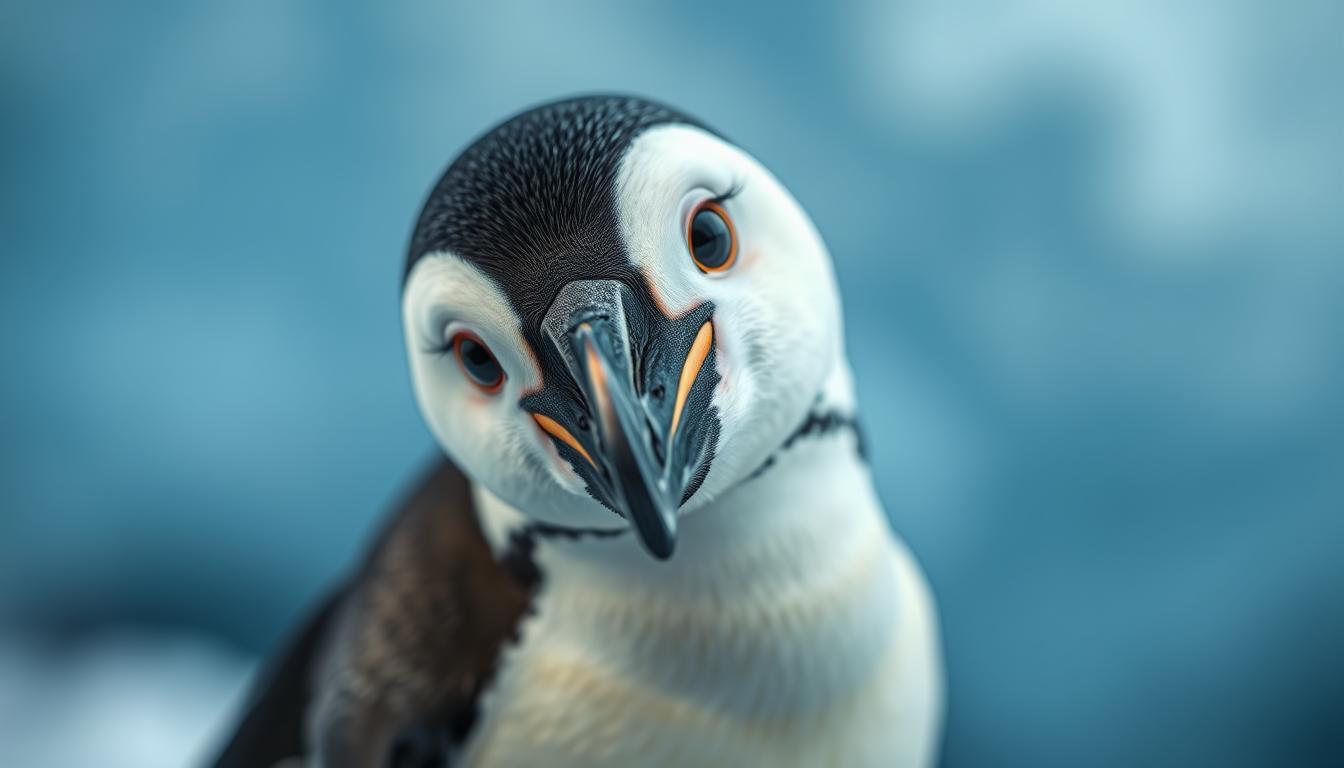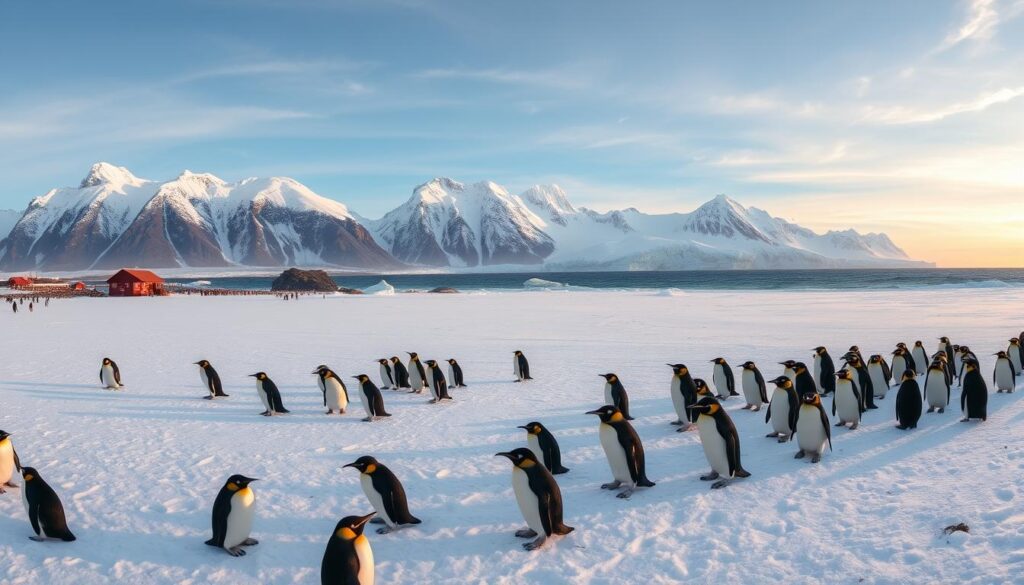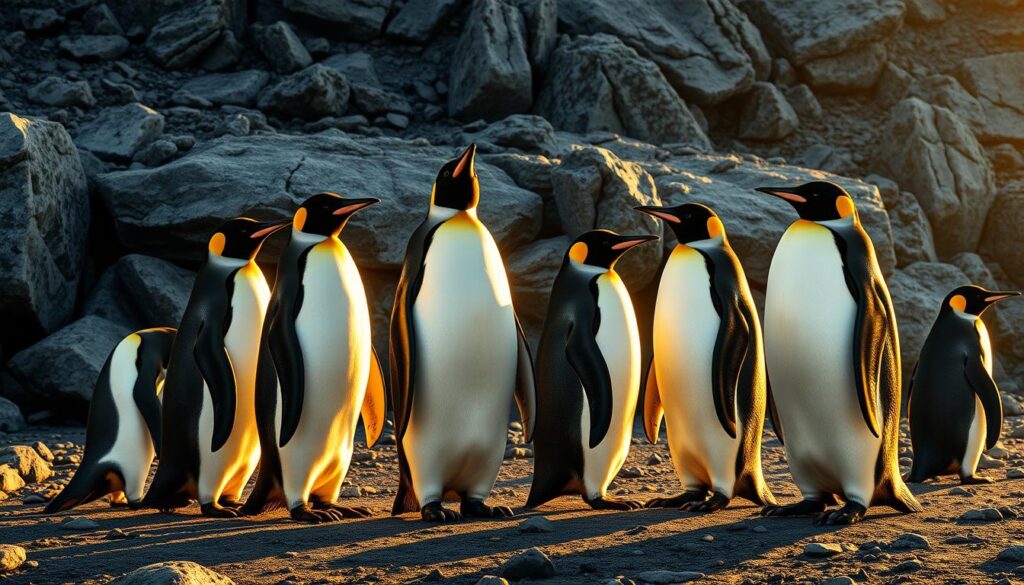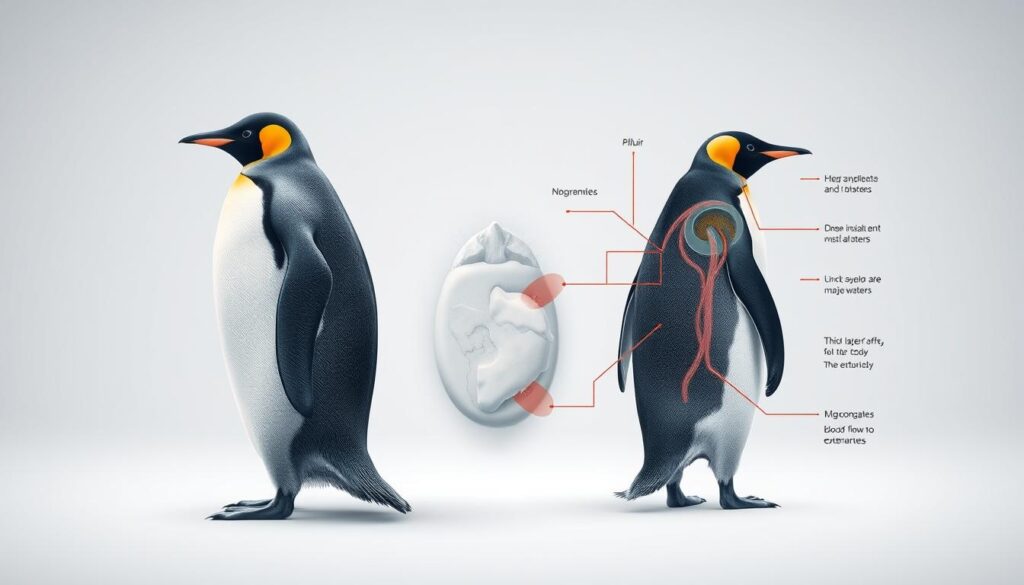Physical Address
304 North Cardinal St.
Dorchester Center, MA 02124
Physical Address
304 North Cardinal St.
Dorchester Center, MA 02124

Have you ever wondered how penguins survive in the cold Antarctic and sub-Antarctic regions? Their special adaptations make them truly fascinating.
Penguins are famous for their black and white feathers. These feathers help them blend in with the sea, making hunting and avoiding predators easier. This amazing trait is just one of the many fascinating things about penguins.
Penguins are not only well-suited to their environments but are also very social. They often live in big groups. Their social behavior is key to their survival, showing just how amazing penguin biology is.
Exploring the world of penguins reveals their unique traits. They are highly adapted to their environments. This makes them stand out from other birds.
Some unique penguin facts include their feathers, which keep them warm. Their flippers also help them swim well. You can find more about these amazing birds by checking out penguin species information.
Penguins are unique among birds because of their special adaptations. Here are a few penguin fun facts that show their uniqueness:

Penguins live in the Southern Hemisphere. You can find them in Antarctica, Africa, Australia, and South America. They live in different penguin habitats, from cold Antarctica to warm tropical islands. You can learn about the places penguins call home and how they adapt to different environments.
Exploring the world of penguins reveals fascinating trivia that amazes everyone. These birds are perfectly adapted to their homes, with special physical and behavior traits. These traits have developed over time.
Penguins have turned into expert swimmers, with their wings changed into flippers. This change helps them live well in water. Their bodies are shaped for speed, and their flippers are strong. They can dive deep to find food.
What’s amazing is how agile penguins are underwater. They use their wings like flippers to move through the water.

Scientists track penguin movements and watch their breeding to study them. This helps researchers understand penguin health and how the environment affects them. You can find more fun facts about penguins in these studies, which are often in detailed fact sheets.
These studies are key for learning about penguin biology. They also help protect penguins by finding areas that need saving. By supporting research and conservation, you help keep these amazing birds safe.
Penguins have amazing physical features to survive in tough places. They live in cold Antarctica and warm Galapagos Islands. Their bodies are adapted to these extreme environments.

Penguins have a special body shape for swimming and diving. Their torpedo-shaped bodies cut through water easily. This is one of the many unique penguin facts that show their adaptability.
Penguins have thick feathers for warmth. Their specialized feathers are packed tightly and keep out wind. This is an amazing penguin fact that shows they can live in cold places.
Penguins stay warm with several tricks. They have fat (blubber) for extra insulation. They also have a special heat-saving system in their legs. These penguin adaptations are key to their survival in cold.
Penguins swim fast and well, thanks to their flippers and bodies. They use their wings like flippers to swim up to 25 miles per hour. This shows their amazing penguin species information and adaptability.
Some penguins dive very deep to find food. The Emperor Penguin dives over 1,800 feet deep. These penguin adaptations let them get food that others can’t.
Many people know about common penguin species, but there are many others that are just as interesting. These diverse penguins show how adaptable and unique they are.
Some penguins are rare and face big threats. The yellow-eyed penguin and the Galapagos penguin are examples of these endangered species.
The yellow-eyed penguin is found in New Zealand and is very rare. Efforts are being made to save its home and prevent it from disappearing.
Penguins come in all sizes. The emperor penguin is the biggest, growing up to 45 inches tall and weighing up to 90 pounds. At the other end, the little blue penguin is the smallest, reaching just about 13 inches tall.
Here’s a comparison of some key characteristics among different penguin species:
| Penguin Species | Height (inches) | Weight (pounds) |
|---|---|---|
| Emperor Penguin | 45 | 90 |
| Little Blue Penguin | 13 | 2.2 |
| Yellow-eyed Penguin | 25 | 8 |
Learning about these unique penguins gives us insight into their biology and challenges. By exploring these fascinating creatures, we can better appreciate the diversity of penguins.
Penguins are very social and live in big groups. They have complex ways of communicating and interacting with each other.
Penguins live in colonies that can have a few dozen to hundreds of thousands of birds. These groups are often around breeding and nesting sites. Penguins form long-term monogamous relationships.
Penguins communicate in many ways, like through sounds, visual displays, and touch. They are very vocal. They use calls to find their mates and chicks and to warn others of dangers.
Penguins have some unique habits, like their mating rituals and how they hunt for food. Some penguins propose with pebbles, while others dive deep to find food.
Let’s explore some of the fascinating behaviors of penguins. The table below shows some of the most interesting penguin behaviors:
| Behavior | Description | Species Example |
|---|---|---|
| Mating Rituals | Penguins use various displays and gifts to attract mates. | Adelie Penguins |
| Feeding Habits | Penguins are skilled hunters, feeding on fish, krill, and squid. | Emperor Penguins |
| Social Colonies | Penguins live in large colonies, often with complex social structures. | Chinstrap Penguins |
These behaviors show how fascinating penguins are. They have complex social interactions and unique mating and feeding habits.
Penguins have a diverse diet that is key to their survival. They are carnivores, eating fish, krill, and squid. Each species has a unique diet based on its environment.
Each penguin species eats what’s available in its home. For instance, Adelie, Gentoo, and Chinstrap penguins mainly eat krill. Emperor Penguins, on the other hand, eat fish, krill, and squid. Their diet changes with the seasons and where they live.
Penguins are great at hunting underwater. They use their wings like flippers to move through the water. They can dive deep and stay underwater for a long time.
Penguins have special features for hunting. Their streamlined bodies and powerful flippers help them catch prey fast. Their feathers also help them hunt underwater, reducing drag and keeping them warm.
Penguins show complex social behaviors in mating and parenting. They are highly social, forming long-term monogamous relationships. Some penguins stay with their mates for up to 20 years or more.
Penguin mating rituals are fascinating. These rituals differ among species but often include elaborate courtship displays. For example, the Emperor Penguin performs mutual preening and vocal calls to strengthen their bond. Some species also give gifts, like pebbles, to their mates.
Penguin parents are dedicated to raising their chicks. Both parents take turns incubating eggs and feeding their young. This shared effort is key for the chicks’ survival, as it allows one parent to forage while the other guards the nest. The Adelie Penguin is a great example, with males and females taking turns incubating eggs on their feet for weeks.
The journey of a penguin chick is filled with challenges. From hatching to fledging, chicks rely heavily on their parents for food and protection. As they grow, they start to venture out of the nest, eventually joining crèches. There, they are watched over by a few adult penguins while the others hunt.
| Penguin Species | Mating Ritual | Parental Care |
|---|---|---|
| Emperor Penguin | Mutual preening and vocal calls | Both parents take turns incubating eggs |
| Adelie Penguin | Gift-giving and vocal displays | Shared incubation and chick-rearing duties |
| Rockhopper Penguin | Elaborate courtship displays | Both parents feed and protect the chicks |
Penguin reproduction and parenting are remarkable processes. They highlight the unique social behaviors of these birds. By understanding these behaviors, we can gain a deeper appreciation for penguins and their habitats.
Penguins face big challenges due to climate change. Rising temperatures and less sea ice change their homes. This makes it hard for them to survive.
Global warming is hurting penguin homes. Sea ice, where penguins live and find food, is melting. For example, Emperor Penguins, the biggest penguins, need sea ice to survive. Without it, they can’t feed or have babies.
| Penguin Species | Habitat | Impact of Climate Change |
|---|---|---|
| Emperor Penguin | Antarctic Sea Ice | Loss of breeding and feeding grounds |
| Adelie Penguin | Antarctic Coast | Changes in food availability |
| Chinstrap Penguin | Sub-Antarctic Islands | Shifts in nesting sites |
Many are working to help penguins. Groups and governments are protecting their homes. They also try to reduce harm from humans.
By supporting these efforts, you can help penguins. You’ll also help keep these amazing birds safe for the future.
Penguins have made their way into our hearts through films and literature. They often appear in media and symbolism, charming us all.
Penguins have become stars of the screen, appearing in movies like “Happy Feet” and “Madagascar.” These films show penguins as charming, curious, and social. They teach us about teamwork and perseverance through children’s books. Their unique looks and behaviors make them a hit with illustrators and authors.
Penguins symbolize loyalty, community, and resilience. Their monogamous nature, with many species forming long-term pair bonds, has made them a symbol of love and commitment. In some cultures, penguins are seen as icons of adaptability, having successfully adapted to harsh, cold environments.
Some interesting facts about penguin symbolism include:
Are you curious about penguins? You’re in the right spot! We have amazing facts for young explorers. Penguins live in the coldest places on Earth and are truly fascinating.
Penguins can’t fly, but they’re great swimmers. Their wings are like flippers, perfect for diving deep to catch fish. They can even drink saltwater because of special glands above their eyes that remove salt!
Penguins have their own way of talking. They use different calls to communicate. Some penguins can be very loud, making sounds like trumpets or donkeys.
There are fun ways to learn about penguins. You can make a penguin habitat diorama with a shoe box, ice, and toy penguins. It shows where penguins live and how they adapt.
Try drawing or painting penguins and their food, like fish and krill. It’s a fun way to learn about their diet. You can also pretend to be a penguin, waddling or sliding, to feel what it’s like.
Penguins have always fascinated humans, and it’s clear why. Their special adaptations, interesting traits, and complex social lives make them stand out. This article has shown how amazing these birds are through fascinating penguin trivia and fun facts.
They can swim incredibly well and have unique mating rituals. Facts like their ability to stay warm in cold temperatures show their adaptability. Their complex social structures prove they’re more than just their fancy feathers.
Reflecting on penguins, it’s clear they’re unique. Their behaviors, physical traits, and charm will keep captivating us for years. Penguins will always hold a special place in our hearts and minds.